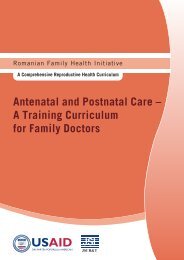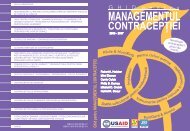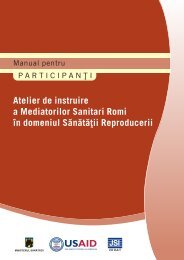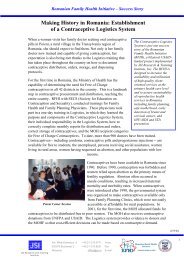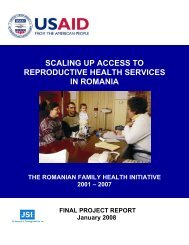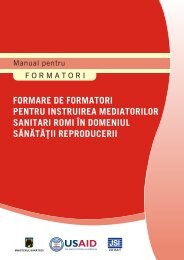Training of Roma Health Mediators in Reproductive Health
Training of Roma Health Mediators in Reproductive Health
Training of Roma Health Mediators in Reproductive Health
You also want an ePaper? Increase the reach of your titles
YUMPU automatically turns print PDFs into web optimized ePapers that Google loves.
• Beside rout<strong>in</strong>e weekly visits <strong>of</strong> the family doctor and/or the nurse, the mediator<br />
should check to see if a newborn is well and facilitate access to a family doctor<br />
for both mother and child if necessary<br />
• Visit<strong>in</strong>g families with babies is an excellent opportunity for the mediator to<br />
answer questions the mother may have about breastfeed<strong>in</strong>g and about the baby’s<br />
development, immunizations and/or other topics.<br />
• Even if the mother has no questions, this is a proper time to <strong>in</strong>form her about the<br />
importance <strong>of</strong> medical supervision, and to recommend that she contact the family<br />
doctor to enroll the newborn on his list <strong>of</strong> patients.<br />
• Another important aspect is the identification <strong>of</strong> potentially serious problems <strong>in</strong><br />
newborns and what to do <strong>in</strong> case they occur.<br />
Expla<strong>in</strong> that a newborn's life may be endangered by serious complications such<br />
as:<br />
o Poor condition <strong>of</strong> the baby (especially <strong>in</strong> pre-term, small for date babies).<br />
Some signs <strong>of</strong> poor condition <strong>of</strong> the baby. The newborn:<br />
• Has trouble <strong>in</strong> breath<strong>in</strong>g<br />
• Breathes faster than 60 breaths per m<strong>in</strong>ute<br />
• Is limp and weak<br />
• Ddoes not have normal color<br />
• Is cold to the touch<br />
o Jaundice. Normally babies may have signs <strong>of</strong> jaundice dur<strong>in</strong>g the first two<br />
weeks <strong>of</strong> life when their eyes and sk<strong>in</strong> become yellowish. This resolves itself<br />
without any medic<strong>in</strong>es. However, if the jaundice does not resolve soon and the<br />
baby looks ill and does not feed properly, it could be a serious complication.<br />
o Sepsis. If the cord-stump is <strong>in</strong>fected, the baby may develop sepsis (<strong>in</strong>fection).<br />
If the baby shows any <strong>of</strong> the follow<strong>in</strong>g signs, he may have a blood <strong>in</strong>fection<br />
and he should be taken immediately at the nearest hospital. The baby:<br />
• Does not feed as well as usual<br />
• Sleeps most <strong>of</strong> the time<br />
• Vomits or spits up a lot<br />
• Has green watery stools<br />
• Sk<strong>in</strong> feels hot or cold<br />
• Breathes too fast or too slow<br />
Sometimes complications may occur rapidly; this is why is important to recognize alarm<br />
signs and to take the baby to a hospital or call the family doctor immediately if they<br />
occur.<br />
Indicate the pages <strong>in</strong> the <strong>Roma</strong> <strong>Health</strong> Mediator Manual where these alarm signs are<br />
described.<br />
Make a very briefly presentation <strong>of</strong> the tra<strong>in</strong>er/participant document Later Care <strong>of</strong> the<br />
Infant. Ask participants if they have any question. Distribute the participant documents.<br />
133<br />
RFHI/JSI <strong>Roma</strong>nia <strong>Tra<strong>in</strong><strong>in</strong>g</strong> <strong>of</strong> RHMs <strong>in</strong> <strong>Reproductive</strong> <strong>Health</strong> Session 8: Newborn Care



